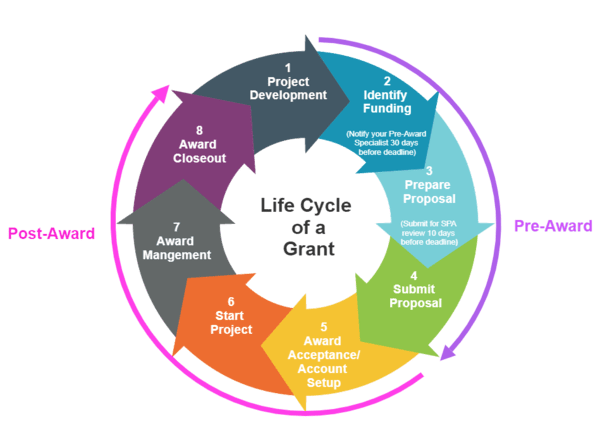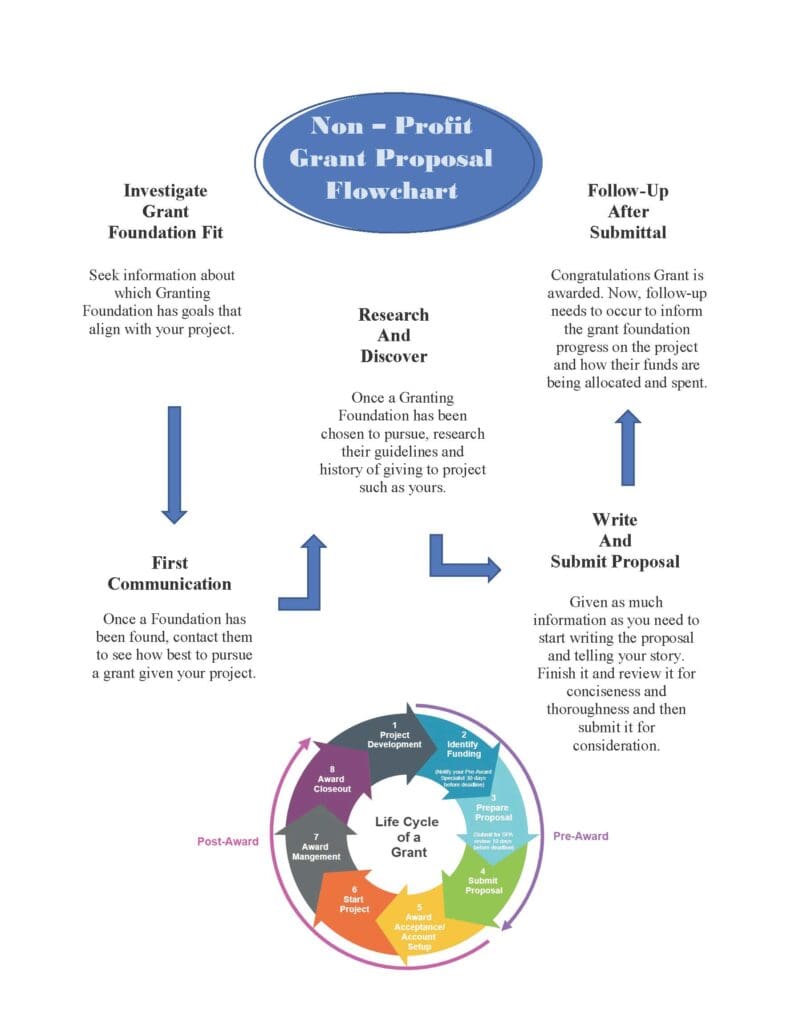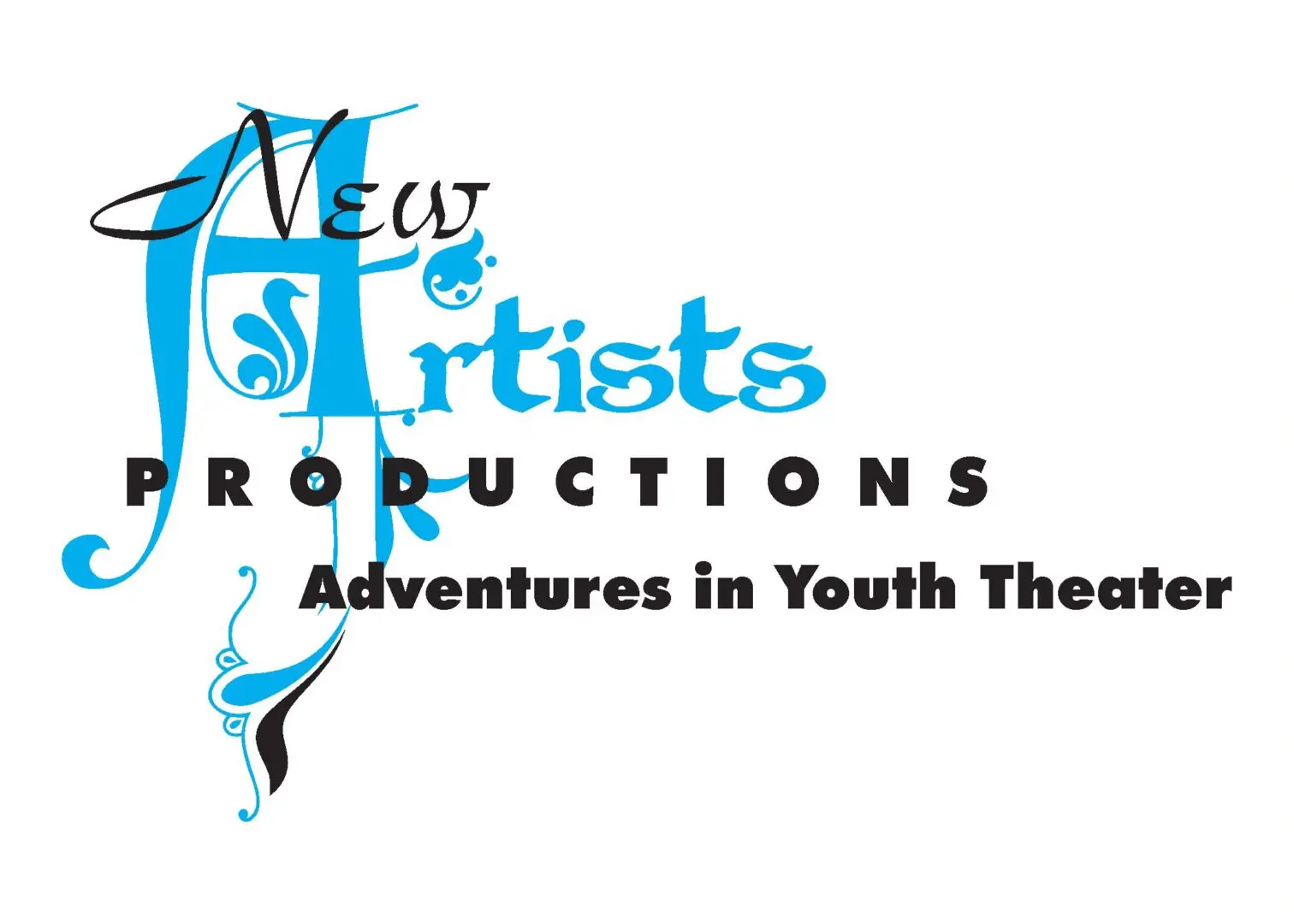
Grant Writing Process
The Process of Non-Profit Grant Proposal Writing: Steps to Successful Submittal and Acceptance
Just like reading a book; if the story is good, then you will finish the read and draw a conclusion as to its success. Otherwise, the book returns to the shelf.

Grant Process Cycle
Grant writing is not different – Do you have a good intriguing story to tell? If the answer is ‘YES,’ then you are on your way to preparing an application that will be read and highly considered for funding.
Preparation of information to convey to the ultimate reader is the key. There are general steps to follow, with the main focus being the project description. Review the success it will have for the organization and ultimately the community.
The following 'JUMP' link is a great way to start the process to preparing a non-profit grant proposal. Acquisition of the needed funding is the outcome.
Do Your Grant Writing Basics Homework
Grant Foundation Research – Oftentimes the organization seeking funding doesn’t know what type of funding is needed to successfully achieve the project goals. Inquiry within the community will provide answers for other funding opportunities: businesses, private donors, local fundraising opportunities and events, cash on hand, etc. to achieve the financial needs.
A Grant Foundation proposal is the answer for additional funding needs. The search for the right foundation must begin. Does the grant foundation support your project category? The Internet has great information about local funding foundations. In addition, inquiry with other local organizations who have previously received grants will provide a good lead.
Information and direction of funding pursuits saves time and oftentimes structures the approach to a granting foundation. Gleaning information and/or ideas of approach to a grant foundation is the most valuable step a grant seeker can take.
First Contact – If a potential candidate for funding is found, reach out to them to see what is required to be considered for funding. Many foundations have websites that itemize funding interests and make application paperwork available for download. Still, if there are questions, it is important to contact the foundation to get answers, get your organization’s name known, and to also determine who reviews the application in-house.
- Who is the audience? Who will be reading the application and making recommendations for approval?
- Focus and address the cover letter to the Board appointed person or team. Open the door to communication.
Research and Discussion – Once a project has been chosen by your organization and a person chosen to spear-head the information gathering required for the grant and, ultimately, write the grant application, the real work begins. Discuss and finalize thoughts about every ounce of information about the project. Answer any questions with full and solid responses. Gather all pertinent information and be comfortable that the grant will write itself from here.
Grant Foundation Information Available:
- Inquiry with potential Grant Foundations for best fit with your project.
- Grant Foundation website: grant guidelines and application process.
- Focus on the granting foundation and what their mission statement is regarding funding opportunities.
Project Team Grant Writer - Grant Team Approach (Local Information):
- Interview the key people involved in the project. … Ask lots of questions to gain a full understanding of the project.
- Conduct consultation sessions to gather data and insight into the non-profit organization and what they are looking for in funding.
- Plus, gain an understanding of the people who will implement the project once funded.
- Breakdown of Board of Directors and supporters involved and their skills and talents.
Write and Submit – It may take several iterations and revisions to get the story ‘just right.’ There is only one opportunity to finalize the submittal to the granting foundation, so take your time and make sure to answer all questions.
Application Process:
- Pull all the details together into a cogent dialog about the project.
- Beginning – Middle – Ending: All so important to get across to the audience.
- Clearly and eloquently define:
- What the goals for the project are.
- Determination of project success.
- Application might be or include a short letter, an online application, a five-page narrative, an in person interview, etc.
- If the application is online, the submittal will be much different than a paper document submittal. The information and story presented should follow the format of the application.
- ONLINE SUBMITTAL: Be concise as the information and format might character content and attachment files. So be concise and direct to the point of why your organization is seeking funding.
- USPS MAIL SUBMTTAL: A mailed submittal may differ in page quantity and provide more detail information vs. online. But, again, the information should be the same as the online version.
Follow-up – If the project period is a lengthy one (up to a year or more), the granting foundation usually require interim progress reports to make sure that everything is on track. Foundations usually provide a progress form or require a formal letter showing project status. Report the use of the grant funding.
Status reporting is vital to the success of the relationship with the funding organization as they don’t like to be kept in the dark about how their money is being used.
For Historical Purposes: a Foundation requires a Project End Report to summarize the project completion and its results. Give special consideration to the funding's impact on the completion. If no report request is required, inquire as to how the grant closure is handled. Occasionally, description of the spending and disbursement of the funds leads to future funding.
Do Your Grant Writing Basics Homework
Before starting a grant proposal, make sure your research is complete. Therefore, you should know:
- The funding priorities.
- Application process.
- Application deadline.
- The organization’s grant history.
- The granting foundation’s geographical distribution.
- The average grant award size.
Important Questions to Ask:
- Who will be implementing the project requirements to success?
- What are the qualifications of this person/team to make it so and make the project successful?
- What is the timeline for the project?
- Does the project timeline meet any specified timeline of the funding?
- Average Grant Size: It is important to note that if the grant award is less than the project requires, seek opportunities to team with like-minded grant foundations through an established consortium of foundations.
- Oftentimes the grant funders have a group of foundations they work with to provide the total funding required, but in smaller pieces.
- If the project warrants it, the original granting foundation usually suggests this joint opportunity and will support the effort through a letter or direct contact.
- Investigate the idea of a consortium prior to sending in the final proposal.
- Without a formal consortium agreement, mention communication with other foundations. This helps stimulate granting foundations to join forces to make the project happen.
Once you know all the details surrounding a grant, you then can ask the right questions when contacting a grantor. This is the path to building that important relationship with the people who are awarding the grants.
